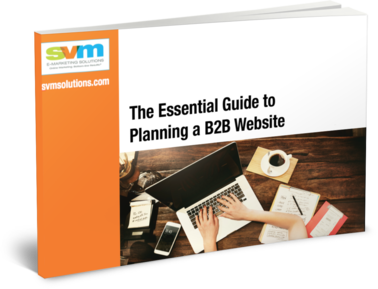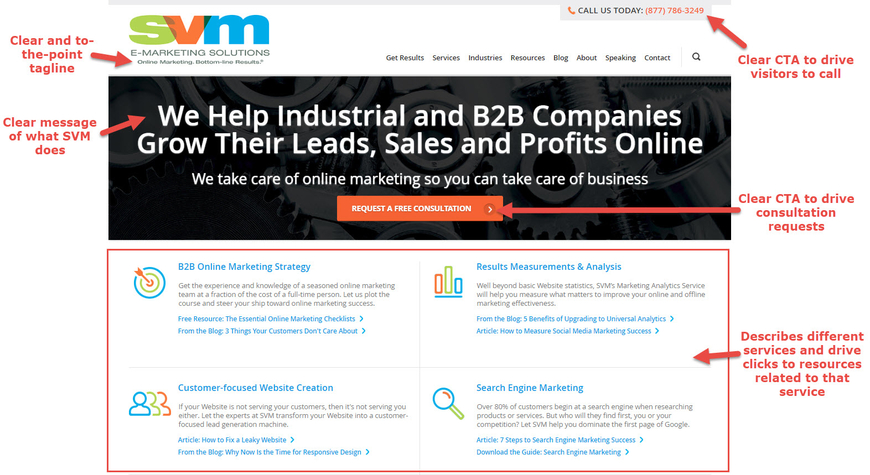CALL US TODAY: (877) 786-3249 x3
Schedule a Strategy Session
 The creation of an effective website involves careful consideration of a wide range of strategic, creative and technical tactics. If you’ve ever been involved in a website launch, you know how overwhelming of a process it can be. This guide was created to help you through that chaos with the goal of driving measurable business results.
The creation of an effective website involves careful consideration of a wide range of strategic, creative and technical tactics. If you’ve ever been involved in a website launch, you know how overwhelming of a process it can be. This guide was created to help you through that chaos with the goal of driving measurable business results.
This B2B website planning guide will provide you with a 7-step plan to define an effective strategy through the following tactics:
Since 1995, SVM E-Marketing Solutions has been creating customer-focused websites that generate leads, increase sales and produce profitable long-term customers. We are here to help you if you need guidance through each step.
To get started, download SVM’s B2B Website Planning Guide today!
We respect your privacy.
The creation of an effective website involves careful consideration of a wide range of strategic, creative and technical tactics. If you’ve ever been involved in a website launch, you know how overwhelming of a process it can be. This guide was created to help you through that chaos with the goal of driving measurable business results.
This B2B website planning guide will provide you with a 7-step plan to define an effective strategy through the following tactics:
Since 1995, SVM E-Marketing Solutions has been creating customer-focused websites that generate leads, increase sales and produce profitable long-term customers.
We are here to help you if you need guidance through each step.
Before starting a website development project, it is important to step back and take a broad view of your B2B company’s goals and objectives. An effective website should help you achieve a number of business goals. And, those goals should be SMART: Specific, Measurable, Attainable, Relevant, and Timely. For example: Increase the number of monthly qualified leads by 20% in the next 6 months. This goal is measured by calculating the number of leads for month 0 and comparing it to month 6.
It is essential that you align your company’s online marketing objectives with your overall business and marketing objectives to ensure you are on the right path for success. To define the goals and objectives for your new website, we’ve outlined a few questions to consider.
1. What are the primary objectives for your new website?
2. What are your short- and long-term goals for your website?
Short-term goals are those that can be achieved in the near future: days, weeks, 2-3 months. Long-term goals take a longer view: 6-9 months, a year, 2-3 years. Setting both short- and long-term goals will help establish a purpose for everything you do during the website planning process and after. And, they will provide a path for change and adaptation over time.
Examples of short-term goals:
Examples of long-term goals:
3. How will your website fit into your overall business strategy?
Your website should be considered an integral part of your business strategy while making sure that it is focused on serving customers’ needs. It can help you achieve a number of business goals such as generating leads, building a marketing database, enhancing customer service and more.
4. How will your website fit into your marketing strategy?
A website is an effective way to attract, convert, nurture and measure your prospective leads online. Your marketing strategy will drive the content, layout and functionalities on your site.
5. What is the budget for this website development project?
The statement “you get what you pay for” is as true as it can be when it comes to website development. Setting a realistic budget starts by understanding what you want the website to do. How much content will your site need? Will you need a lot of customized technology and design elements or will a standard WordPress theme suit your needs? Once you know what you want, request proposals from web development agencies so you can see how much a website of that caliber will cost. And, set a budget from there.
6. What are the schedule requirements for your new website’s development? When does the website have to be live?
Make sure the new website is being developed during a time-frame that is not too busy for whoever is going to be working on it. Website planning is extremely time consuming. And, it should launch when you and your team can easily digest it. That schedule should be shared with your web-design company or whoever is going to be developing and designing the site.
 7. Who is going to fill the different roles and accomplish the different tasks during the website development?
7. Who is going to fill the different roles and accomplish the different tasks during the website development?
Team work is important during website development as there are a lot of moving pieces. Some of the important roles to delineate are:
If you want to drive conversions from your website, you need to know who your primary audience is, what they want, what matters to them and what problems you can solve for them. Only by meeting their particular needs will your website be successful in spurring them into action: requesting information, placing an order, signing up for a newsletter, bookmarking your site for future reference, etc.
Take a moment to brainstorm about your target audiences. Who are they? What goals do you have for them? What information or features will each audience group need? By targeting specific audience groups, you will be able to meet their individual needs.
Consider the following when defining your target audience.
The online world has been the great equalizer in that it has leveled the playing field by providing companies, even small businesses, the opportunity to compete with their largest competitor. An effectively designed website can make a small company look large. And, a poorly designed website can make even a large successful company look small and insignificant.
It is important that your website stands out among your online competitors, big or small. Your site needs to make a great first impression and follow up with valuable information and features to successfully convert visitors into customers. How can you ensure that you stand out? Start by reviewing your competitor websites. You can learn a lot from your competitors’ online successes and failures.
If you are unsure of who your online competitors are, do a Google search on industry terms and make a list of the companies that are ranking on the first page of search results. If you are a fuel equipment company, you might do a search for “fuel management solutions” or “petroleum equipment company”.
Once you have a list of your top competitors, take a look at their websites and make a list of what you like and dislike about their websites. And, take notes about how your company differs and is better than these competitors.
As you review their sites, ask yourself the following questions:
As you are going through the different competitor sites, I recommend taking notes in a Word document or PowerPoint deck and include screenshots with callout boxes to make it easy to share with other members of your team. For example:

Most clients we work with have an existing website that does not fully meet their needs. You most likely feel the same way about your site or you would not be reading this guide. While your website may need significant improvements, there may be aspects that are working and should remain in your new and improved website.
The first step is to take a look at your website and figure out your current strengths and weaknesses. Involve other people in your organization as well as outsiders in this discussion. It is important to understand how your target market sees your website as it may differ from internal company views. The easiest outside audience to reach out to is your current client base. But, you can also reach out to former business prospects, former employers and/or industry influencers for feedback. The more feedback, the better. This information will go a long way toward determining how an updated website can better meet your and your customers’ needs.
When you are reviewing your website, be specific as to what you believe works and doesn’t work for your company:
If you have an analytics tool such as Google Analytics set up on your current website, this is another source of valuable information you can review when evaluating your own website.
1. Determine the content visitors are reading
What content on your current website is the most visited? Are they spending time reading your product or service content or are most of the visits to the resource center? The pages that are heavily visited and perform well should be on the new website. And, keep a similar title to keep past SEO power. Also, take a look at high-bounce pages and try to understand what may be causing those visitors to leave so quickly before the website redesign.
2. See which conversions are performing best
If you have conversions tracking on your site, review what is working and what isn’t. What are current visitors attracted to and what is left untouched? CTAs that are utilized should be transferred to the new website. The ones that are not performing should be rethought or completely eliminated.
3. Find out where your visitors are coming from
The source of your traffic can vastly change your marketing strategy. If the majority of your traffic is coming from search engines, you need to make sure your site continues to be search-friendly. If you are generating the majority of your traffic from social media, you will need to make sure your content is interactive and social-share friendly.
4. Learn what people are searching for on your site
If you have a search box on your site, tracking that information can help you determine if people are finding what they are looking for on your site. It can also give you ideas for new content to create.
5. Determine where people abandon the checkout process
If you are selling products online, understanding your checkout process is important. Tracking the steps that people take during the purchasing process and where they may abandon the shopping cart will help you understand what needs to be done to make your website more shopping friendly. For example, if you see that a high-amount of people leave when they see the shipping prices, it may be time to review those fees. Or, if you see that people exit before confirming their order, it may mean that something is not working or something might be stopping them from finalizing their order.
Now that you have worked out the goals of your new website and who your audience is, it is time to make sure you provide your target audience with content that is going to drive action. And, make sure your content is found by search engines.
When you were completing your website and competitor review, you should have come up with a list of pages that must be transferred from your current site as well as a list of pages that need to be created. If you haven’t, take a moment to think about it now.
Once you have figured out what content will be presented on the website, start thinking about where the content will come from. Will it be new, re-purposed, or both? Also, how often will you add new content and who will update the content?
Before rushing to update and create new content, take a step back and start thinking about search engine optimization (SEO). SEO will get you in front of motivated customers when they are actively searching for your products and/or services on Google and other search engines. The concept is fairly simple: figure out which phrases people are using when they are searching for your products/services and make sure you have content that ranks for those terms. For more information about SEO, take a look at our Essential Guide to B2B Search Engine Marketing.
Remember your website is for your customers, not you. All content should focus on their needs. The keywords you have chosen to focus on should be worked into the content. This will help search engines understand what words you are attempting to rank for. SEO is an ongoing method with many moving parts, but conducting keyword research during the website planning process helps make sure your website has a good foundation of content that your target market is looking for.
We have made a lot of progress in this guide. We know your overall goals, who your target audience is, who your competitors are, what kind of feedback you have about your existing site, and how your new site will serve your target audiences.
Now it is time for one of the most important steps of the website planning process – defining your success measures.
How will you know if your website is a success? By defining specific measurable results you would like your site to achieve.
Some examples of success measures include:
This guide defines a proven approach to B2B website planning that will produce measurable results. By considering the steps and best practices detailed in this guide, you have now taken the crucial first steps toward achieving your online marketing goals.
Now, it’s time to take action to profit from these principles. Assemble a team of talented online marketing strategists and developers to bring your website plan to life.
We hope this B2B website planning guide has helped simplify the process of making sure your new site serves your target audience and persuades them to take action. The principles detailed in this guide are based on SVM’s over twenty years of experience creating effective online marketing strategies that produce measurable business results for manufacturers, distributors and B2B service providers. For more guided online marketing strategies, take a look at our guide resource center. We have a guide for each high-level online marketing activity.
A great next step will be to set up a free consultation with me, Bob DeStefano, to discuss your B2B online marketing strategy.
I guarantee I’ll provide you with tips and ideas you can use immediately to boost your results.